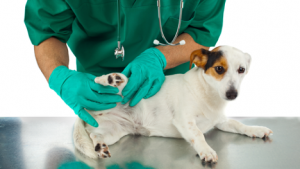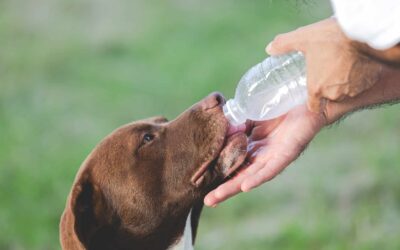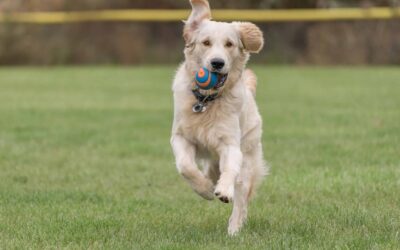Hip Dysplasia in Dogs [Signs, Symptoms & Treatment]

Your dog is a sweet companion. Keeping your pet as healthy as possible is a priority. Canine hip dysplasia is experienced by many dogs. Fortunately, there’s hope for dogs with hip dysplasia. This article will help you discover all you need to know about canine hip dysplasia – from its causes and symptoms to treatment options and prevention strategies.
Understanding Canine Hip Dysplasia
Hip dysplasia isn’t a congenital problem in puppies at birth. Hip dysplasia may occur as the puppy’s hip joints develop and grow. When their hip joint doesn’t grow properly, it causes the hip joint to rub together instead of sliding smoothly. Hip dysplasia affects both large and small dog breeds. Some dogs limp due to hip dysplasia, but others never experience pain or lameness. Often, it’s only when a dog is older and develops arthritis that hip dysplasia is diagnosed.
Causes and Risk Factors of Canine Hip Dysplasia
Several factors contribute to hip dysplasia. But this disease affects a dog’s:
- Environment
- Overfeeding
- Growth rate and nutrition
- Too much Exercise
Environment
Three-month-old puppies raised in an environment with access to stairs or slippery surfaces had a higher risk of hip problems later in life. Puppies allowed to play off-leash on softer, uneven grassy areas had a lower risk of developing this condition. To help your puppy avoid hip problems later in life, restrict their access to stairs or slippery surfaces.
Over-feeding

Large-breed puppies may not get the proper nutrition they need to support their size, leading to skeletal problems such as elbow dysplasia, hip dysplasia, and other joint problems. A study found that dogs overfed as puppies were more likely to develop hip dysplasia later in life. Damage can be done to the hip joint when a dog is overweight. Puppies that weigh more at birth and dogs that grow faster and gain weight too quickly have a higher risk of hip degenerative problems. Puppies on a restrictive diet that keeps them from growing too quickly are less likely to develop hip dysplasia.
What about nutrition for your puppy? Puppies grow quickly. They must get proper nutrition to support their growth. Feed your pup good quality commercial puppy food. Avoid giving your puppy supplements such as calcium unless your vet prescribes them.
Exercise
Of course, exercise is important for a dog to grow stronger, but it’s crucial to ensure your dog is getting the appropriate exercise for their age. Puppies born in the summer had a lower risk of dysplastic hips because they get outside exercise. Dogs aged 12 to 24 months that chased a stick or ball thrown by their parent have a higher risk of hip dysplasia. A puppy’s hips’ most crucial growth and development period is from birth to eight weeks.
How much exercise does your puppy need?
Talk to your vet to determine how much exercise your puppy should get. They will have a general idea of your dog’s needs according to their age and breed. Be aware of any signs your puppy is in pain or tired, which could be a symptom of too much exercise or a more serious problem.
Which Breeds Are Prone to Canine Hip Dysplasia?
Hip dysplasia is considered a genetic condition, especially in larger dogs such as
- Saint Bernards
- Great Danes
- German Shepherds
- Labrador Retrievers
- Rottweilers
- Newfoundland dogs
- Bernese Mountain dogs
- Golden Retrievers
How Long Can a Dog Live With Hip Dysplasia?
Dogs diagnosed with hip dysplasia can live full lives with proper treatment. Early detection is key to helping a dog live comfortably into old age. If you think your dog has a hip or joint problem, it’s best to discuss it with your vet.
Glucosamine & Omega-3 fatty acids: Supplements for Dogs with Joint Disease
Your vet may prescribe glucosamine for a dog with hip and joint problems. This supplement supports joint health and reduces a dog’s discomfort. Dogs with hip dysplasia can also benefit from omega-3 fatty acids.
Identifying Symptoms of Hip Dysplasia in Dogs
Often, hip dysplasia can go unnoticed. Common symptoms include
- Limping, not due to an injury
- Hopping when they should be running
- Popping sounds in a dog’s joints
- Trouble standing,
- Sitting in a weird position
- Trouble getting on and off furniture
- Trouble walking up or down the stairs
- Trouble getting into a car
Even if dogs don’t show symptoms, they could be in pain. If you notice these symptoms, be sure to talk with your vet.

Diagnosing Canine Hip Dysplasia
Diagnosing hip dysplasia is done with an imaging technique called a hip radiograph. Radiography uses ionizing, non-ionizing, gamma, or X-rays to see an internal form. A dog is put under general anesthesia to see the condition of the hip joint.
Treatment Options for Canine Hip Dysplasia
How a dog is treated depends on their symptoms and discomfort levels. Treatment options include:
- Anti-inflammatory drugs NSAIDs
- Surgery
- Supplements such as omega-3 or glucosamine
- Vet-prescribed medications such as tramadol or amantadine, both pain medications
- Keep your dog from activities such as jumping, running, or excessive walking
Types of surgeries
DPO/TPO – This surgery is for young dogs under ten months old. The surgeon cuts the pelvic bone and the rotating parts to improve the ball and socket joint function.
FHO – This hip surgery works for young or older dogs. The surgeon removes the head of the hip joint, which causes the dog’s body to create a “bone” joint out of bone. This bone creation lowers the pain from hip dysplasia.
THR – This is a very effective surgery for dogs with hip dysplasia. The surgeon will remove the hip joint and replace it with a plastic or metal implant. The dog’s hip range will return to normal, eliminating most discomfort.
Surgery always carries some risks. Possible risks due to hip surgery include:
- Infection
- Loosening of implants
- Nerve damage
- Hip dislocation.
Preventing Hip Dysplasia in Dogs
Responsible breeding and lifestyle modifications can be key in preventing hip dysplasia. Breeders can screen their birthing dogs for any hereditary tendencies towards hip problems. As the puppies grow, feeding them a nutritious diet for healthy joint and bone development. Giving a puppy appropriate exercises on soft surfaces can also prevent hip dysplasia later in life.
Prognosis and Long-Term Outlook for Dogs with Hip Dysplasia
Dogs diagnosed with hip dysplasia can live a long, happy life, but it comes at a cost to you and your pet. They may need hip surgery and long-term treatment management, which can affect a dog’s quality of life. Be sure to work with your vet to keep your dog’s weight healthy and provide routine checks on your dog’s hip joints.
Can Hip Dysplasia Surgery Be Covered by Pet Insurance?
Most pet insurance will cover the costs of hip dysplasia surgery and some long-term treatments. Depending on your chosen insurance plan, coverage may vary for your pet. Before you choose pet insurance, be sure you understand what is covered in the policy and what things you are responsible to cover.
Illness & Injury Plan
This plan covers illnesses, injuries, and other medical situations like hip dysplasia surgery. Other expenses include lab tests, cancer treatment, CT and MRI scans, emergency vet visits, and overnight stays. This comprehensive plan is perfect for a young puppy or a dog without a pre-existing condition.
Wellness Plan
Odie’s Wellness Plan is an add-on to existing pet insurance. It covers preventative care such as vaccinations, wellness checks, and dental cleanings. This plan doesn’t cover hip dysplasia surgery but provides routine care to prevent and diagnose hip or joint problems.
FAQs:
What Are the Non-Surgical Treatment Options for Hip Dysplasia?
Non-surgical treatment options include
- Anti-inflammatory drugs (NSAIDs)
- Supplements such as omega-3 or glucosamine
- Vet-prescribed medications such as tramadol or amantadine, both pain medications
- Keep your dog from activities such as jumping, running, or excessive walking
When Is Surgery Recommended for Hip Dysplasia?
Your vet may recommend surgery for your dog’s hip dysplasia if your sweet pet’s lifestyle is hindered due to pain and discomfort.
Can My Dog Live a Normal Life With Hip Dysplasia?
With the right treatments, a dog can live a happy, healthy life with hip dysplasia.
Can Hip Dysplasia Be Completely Cured in Dogs?
There isn’t a cure for hip dysplasia, but there are long-term treatments that can make a dog’s life happy and healthy.





